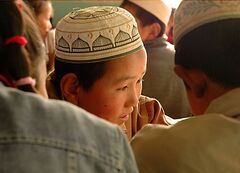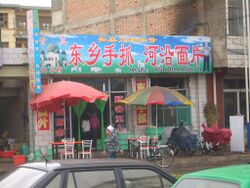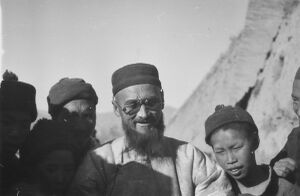دونگشيانگ (شعب)
دْوݣسِيْاݣ | |
|---|---|
 طالب من الدونگشيانگ في المدرسة | |
| إجمالي التعداد | |
| 621,500 | |
| المناطق ذات التجمعات المعتبرة | |
| 621,500 (تعداد 2010) في گانسو | |
| اللغات | |
| Santa | |
| الدين | |
| الإسلام السني | |
| الجماعات العرقية ذات الصلة | |
| Mongolic peoples, Hui, Bonan, Salar |
| جزء من سلسلة عن الإسلام في الصين |
|---|
 |
|
|
The Dongxiang people (autonym: Sarta or Santa (撒尔塔); simplified Chinese: 东乡族; traditional Chinese: 東鄉族; pinyin: Dōngxiāngzú, Xiao'erjing: دْوݣسِيْاݣذُ) are Mongolic people and one of 56 ethnic groups officially recognized by the People's Republic of China. Most of the Dongxiang live in the Linxia Hui Autonomous Prefecture and surrounding areas of Gansu Province in Northwestern China, half of them in Dongxiang Autonomous County, which is part of Linxia. According to the 2010 census, their population numbers 621,500, although research has found that the number is inflated due to Hui identifying themselves as Dongxiang for the census, in order to benefit from minority policies.[1]
الأصل والتطور
The Dongxiang are closely related to other Mongolic peoples like the Monguor and Bonan. Scholars[من؟] speculate that their identity as an independent ethnic group arose through contact with Central Asians, due to whom the Dongxiang converted to Sunni Islam in the 13th century.
For years, many Chinese scholars assumed that the Dongxiang were descendants of Mongolian troops posted in the Hezhou area by Genghis Khan (1162-1227 AD). Another possibility is that they could be a mixture of many peoples including Mongolian, Han and Tibetan groups.[2] Yet another theory states the Dongxiang's origin lies in the thirteenth century when Mongol soldiers were stationed to garrison the Linxia and Western Gansu region during the Mongol's conquests of Northern China.[3] Genetic studies have shown that the majority of Dongxiangs share very similar genetic membership with other East Asian populations, revealing a common genetic makeup. The Dongxiangs also showed significant genetic homogeneity with the Han Chinese, which supports a simple cultural diffusion for the origin of the Dongxiang in China.[4]
The American Asiatic Association published an account of the Dongxiang's origins in the "Asia, Volume 40". A Muslim Mongol, Ma Chuanyuan, who was the supermagistrate of five districts, was interviewed and gave a story on his people's origins. The conversion to Islam by a clan descended from Genghis Khan angered their relatives, who drove them all the way to Eastern Linxia. This occurred at the twilight of the Yuan dynasty. East Linxia was described as a land of "thorns and yellow earth". The author estimated a number of 100,000 Mongolian Muslims. They spoke Mongolian but were all illiterate. The account described them as a community of one hundred thousand, Mongol by race, Islam by religion and Chinese by culture. The majority of them were monolingual.[5][6]
Dongxiang were also known as Santa (San-t'a) people, it was reported that many of them served in the army of the Hui General Ma Fuxiang.[7] It was even said that Ma Fuxiang himself was of Santa descent, who had assimilated into the Hui community.[8]
Their autonym, sarta, may also provide a contradictory clue to their origin: a similar word Sart was formerly used in Central Asia to refer to Arab traders[بحاجة لمصدر], later to the local (mostly) Turkic-speaking city dwellers. Their official name of Dōngxiāng meaning "eastern villages" stems from the fact that their settlements are east of the major Han Chinese settlements.
Like other Muslims in China, the Dongxiang served extensively in the Chinese military. It was said that they and the Salars were given to "eating rations", a reference to military service.[9]
Hui, Baoan and Dongxiang troops served under Generals Ma Fulu and Ma Fuxiang in the Boxer Rebellion, defeating the invading Eight Nation Alliance at the Battle of Langfang. Ma Fulu along with 100 Dongxiang and Hui troops died in fierce combat at Zhengyang Gate in Beijing against the Alliance forces as they fought to the death to hold the Alliance at bay.
Hui, Baoan, Dongxiang, Salar and Tibetan troops served under ما بياو في الحرب الصينية اليابانية الثانية ضد اليابانيين.
التزاوج مع الأعراق الأخرى
The Dongxiang have Mongol, Han Chinese, Hui and Tibetan surnames.[10] Dongxiang with Han Chinese surnames such as Wang, Kang, Zhang, Gao and Huang claim descent from Han Chinese. Surnames such as Ma and Mu are clearly of Hui origin.[11][12]
Some Dongxiang have said that, in the rare instances that they do marry with other people, it is only with Han and Hui, but not Tibetans.[13]
الاقتصاد
The base of the economy of Dongxiang is agriculture. The main products are potatoes, corn, barley, millet and wheat.[14] They are also recognized craftsmen, specializing in the elaboration of traditional carpets.
الثقافة

Common Dongxiang cuisine includes the use of a potato mash that is used for noodles, snacks, alcoholic drinks and more.[14]
Traditional Dongxiang dress for men includes buttoned robes and a broad waistband. These waistbands are sometimes used to hang knives, snuff bottles, or small bags on them. A vest over a white shirt, trousers and a beret like cap makes up the rest of the traditional outfit. Seasonal clothing like sheepskin coats are also worn during the winter. Dongxiang women wear embroidered outfits which include wide sleeved shirts and trousers. Older women wear kerchiefs and younger women tend to wear bright decorated cotton caps and silk veils. On special occasions, women wear embroidered shoes with a medium heel.[14]
اللغة والتعليم
The Dongxiang speak the Dongxiang language, a member of the Mongolic family.[15] The language has distinct features resembling archaic Mongolian and has many foreign loan words borrowed from Arabic, Chinese, Persian, and a few Turkic languages.[3] The Dongxiang people also have a rich tradition of oral literature and use the Arabic alphabet.
As a result of the language shift, some 20,000 people in several villages in the Northeastern Dongxiang County now speak the so-called "Tangwang language": a creolized version of Mandarin Chinese with a strong Dongxiang influence, in particular in its grammar.[16]
Government statistics show that the Dongxiang are among the poorest and least literate of China's minorities, with most Dongxiang having completed only an average of 1.1 years of schooling, a problem aggravated by the lack of a written language.
In 2004, the Ford Foundation provided US$30,000 in grant money for a pilot project to promote bilingual education in Mandarin and Dongxiang, in an effort to reduce school drop-out rates. The project is credited with the publication of a Dongxiang-Chinese bilingual dictionary as well as recent rises in test scores.
الجينات
Distribution of Y-chromosome haplogroups in Dongxiang:[17]
O=24.29(O2=18.69,O1a=1.87,O1b=3.73)
J=16.82
R2=9.35
C=6.54
G=5.61
N=5.6
D=4.67
E=3.74
Others=6.56
In another study in 2010 found that the majority of the Dongxiang belonged to Haplogroup R1a (R1a : 54%).[18]
مشاهير الدونگشيانگ
المراجع
- ^ Xu, Dan, Xiaodong Xie, and Shaoqing Wen. "The Dongxiang language and people." (2013).
- ^ Jim Yardley (March 7, 2006). "Poor, illiterate and unaware they're in China". THE NEW YORK TIMES. Retrieved 2011-06-27.
- ^ أ ب Dillon, Michael (1996). China's Muslims. Hong Kong: Oxford University Press. pp. 13. ISBN 0195875044.
- ^ Yao, Hong-Bing; Wang, Chuan-Chao; Tao, Xiaolan; Shang, Lei; Wen, Shao-Qing; Zhu, Bofeng; Kang, Longli; Jin, Li; Li, Hui (2016-12-07). "Genetic evidence for an East Asian origin of Chinese Muslim populations Dongxiang and Hui". Scientific Reports (in الإنجليزية). 6 (1): 38656. doi:10.1038/srep38656. ISSN 2045-2322.
- ^ American Asiatic Association (1940). Asia: journal of the American Asiatic Association, Volume 40. Asia Pub. Co. p. 659. Retrieved 2011-05-08.
- ^ Hartford Seminary Foundation (1941). The Moslem World, Volumes 31-34. Hartford Seminary Foundation. p. 182. Retrieved 2011-05-08.
- ^ Pamela Kyle Crossley (2002). A Translucent Mirror: History and Identity in Qing Imperial Ideology. University of California Press. p. 142. ISBN 978-0-520-23424-6. Retrieved 2010-06-28.
- ^ Louis M. J. Schram (2006). The Monguors of the Kansu-Tibetan Frontier: Their Origin, History, and Social Organization. Kessinger Publishing. p. 23. ISBN 978-1-4286-5932-2. Retrieved 2010-06-28.
- ^ Christian Literature Society for India, Hartford Seminary Foundation (1920). Samuel Marinus Zwemer (ed.). The Moslem World, Volume 10. Hartford Seminary Foundation. p. 379. Retrieved 2011-06-06.
- ^ James Stuart Olson (1998). An ethnohistorical dictionary of China. Greenwood Publishing Group. p. 66. ISBN 978-0-313-28853-1. Retrieved 2010-06-28.
- ^ Henry G. Schwarz (1984). The minorities of northern China: a survey. Vol. 17 of Studies on East Asia (illustrated ed.). Western Washington. p. 100. ISBN 978-0-914584-17-9. Retrieved 17 July 2011.(Original from the University of Michigan )
- ^ Richard V. Weekes (1984). Richard V. Weekes (ed.). Muslim peoples: a world ethnographic survey, Volume 1 (2, illustrated ed.). Greenwood Press. p. 238. ISBN 978-0-313-23392-0. Retrieved 17 July 2011.(Original from the University of Michigan )
- ^ Colin Legerton; Jacob Rawson (2009). Invisible China: A Journey Through Ethnic Borderlands. Chicago Review Press. p. 156. ISBN 978-1-55652-814-9. Retrieved 2010-06-28.
dongxiang han hui marriages.
- ^ أ ب ت Elliot, Sheila Hollihan (2006). Muslims in China. Philadelphia: Mason Crest Publishers. pp. 65. ISBN 1-59084-880-2.
- ^ Henry Serruys; Françoise Aubin (1987). The Mongols and Ming China: customs and history, Volume 1. Variorum Reprints. p. cxv. ISBN 978-0-86078-210-0. Retrieved 2010-06-28.
- ^ International Council for Philosophy and Humanistic Studies (1996). Atlas of languages of intercultural communication in the Pacific, Asia, and the Americas, Volume 2, Part 1. (Volume 13 of Trends in Linguistics, Documentation Series). Walter de Gruyter. pp. 875–882. ISBN 978-3-11-013417-9.
- ^ Wen, Shaoqing; Xu, Dan (2017), The Silk Road: Language and Population Admixture and Replacement, Springer, Singapore, pp. 55–78, doi:, ISBN 9789811041686, https://hal-inalco.archives-ouvertes.fr/hal-01935687
- ^ Xiao, Chun-Jie; Tang, Wen-Ru; Shi, Hong; Tan, Si-Jie; Dong, Yong-Li; Wei, Chuan-Yu; Qiao, En-Fa; Shou, Wei-Hua (May 2010). "Y-chromosome distributions among populations in Northwest China identify significant contribution from Central Asian pastoralists and lesser influence of western Eurasians". Journal of Human Genetics. 55 (5): 314–322. doi:10.1038/jhg.2010.30. ISSN 1435-232X. PMID 20414255.
 هذه المقالة تتضمن نصاً من The Moslem World, Volume 10، بقلم Christian Literature Society for India, Hartford Seminary Foundation، وهي مطبوعة من سنة 1920 وهي الآن مشاع عام في الولايات المتحدة.
هذه المقالة تتضمن نصاً من The Moslem World, Volume 10، بقلم Christian Literature Society for India, Hartford Seminary Foundation، وهي مطبوعة من سنة 1920 وهي الآن مشاع عام في الولايات المتحدة.
وصلات خارجية
- The Dongxiang
- The Dongxiang ethnic minority (Chinese government site)
- Dongxiang in China
- Oliver Corff: The Dongxiang Mongols and Their Language
- Ford Foundation Grant Information: Narisi Primary School of Dongxiang Autonomous County
- Poor, illiterate, and unaware they're in China
- Dongxiang people history and photo gallery
- Short description is different from Wikidata
- "Related ethnic groups" needing confirmation
- Articles using infobox ethnic group with image parameters
- Articles containing simplified Chinese-language text
- Articles containing traditional Chinese-language text
- جميع المقالات الحاوية على عبارات مبهمة
- جميع المقالات الحاوية على عبارات مبهمة from February 2018
- Articles with unsourced statements from February 2007
- Mongol peoples
- شعب دونگشيانگ
- الإسلام في الصين
- Muslim communities of China
- Ethnic groups officially recognized by China


